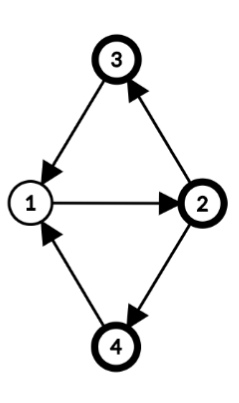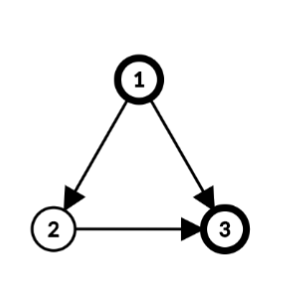In the country $$$N$$$, there are $$$n$$$ cities connected by $$$m$$$ one-way roads. Although this country seems unremarkable, there are two interesting facts about it. At first, a week lasts $$$d$$$ days here. At second, there is exactly one museum in each city of the country $$$N$$$.
Travel agency "Open museums" is developing a new program for tourists interested in museums. Agency's employees know which days each of the museums is open. The tour should start in the capital — the city number $$$1$$$, and the first day of the tour must be on the first day of a week. Each day a tourist will be in some city, watching the exposition in its museum (in case museum is open today), and by the end of the day, the tour either ends or the tourist goes into another city connected by a road with the current one. The road system of $$$N$$$ is designed in such a way that traveling by a road always takes one night and also all the roads are one-way. It's allowed to visit a city multiple times during the trip.
You should develop such route for the trip that the number of distinct museums, possible to visit during it, is maximum.
The first line contains three integers $$$n$$$, $$$m$$$ and $$$d$$$ ($$$1 \leq n \leq 100\,000$$$, $$$0 \leq m \leq 100\,000$$$, $$$1 \leq d \leq 50$$$), the number of cities, the number of roads and the number of days in a week.
Each of next $$$m$$$ lines contains two integers $$$u_i$$$ and $$$v_i$$$ ($$$1 \le u_i, v_i \le n$$$, $$$u_i \ne v_i$$$), denoting a one-way road from the city $$$u_i$$$ to the city $$$v_i$$$.
The next $$$n$$$ lines contain the museums' schedule. The schedule of the museum located in the $$$i$$$-th city is described in the $$$i$$$-th of these lines. Each line consists of exactly $$$d$$$ characters "0" or "1", the $$$j$$$-th character of the string equals to "1" if the museum is open at the $$$j$$$-th day of a week, and "0", otherwise.
It's guaranteed that for each pair of cities $$$(u, v)$$$ there exists no more than one road leading from $$$u$$$ to $$$v$$$.
Print a single integer — the maximum number of distinct museums, that it's possible to visit, starting a trip in the first city on the first day of the week.
4 5 3 3 1 1 2 2 4 4 1 2 3 011 110 111 001
3
3 3 7 1 2 1 3 2 3 1111111 0000000 0111111
2

The maximum number of distinct museums to visit is $$$3$$$. It's possible to visit $$$3$$$ museums, for example, in the way described below.

The maximum number of distinct museums to visit is $$$2$$$. It's possible to visit $$$2$$$ museums, for example, in the way described below.